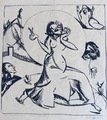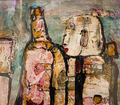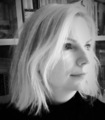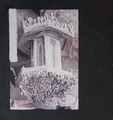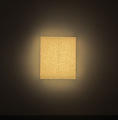Month of March in the galleries of Kaunas 2016-03-29
"I was astonished and after that / I welcomed spring", writes poet Donaldas Kajokas in one of his poems. The abundance and variety of exhibitions taking place in March also astonishes - from the ones looking back at the classic painting school or the topic of war to philosophical, or the ones that celebrate the female beauty in painting.
The aim of rethinking the continuity of time and history and the importance and sacredness of the cloth 2016-03-29
M. Žaltauskaitė-Grašienė's exhibition Attire hosted in Pažaislis, presents the works comprised of three series about women: nymph (Penelope), saint (Virgin Mary) and queen (Victoria). The drapes carved in all of these sculptures are re-weaved by the artist and brought back to the shape of fabric.
Power and riches - collections of kings and noblemen (Part II) 2016-03-25
Collections of Lithuanian aristocrats were as valuable as those of the old European families. Several years ago, Meadows Museum (USA) organized an exhibition of one of the oldest noble European families - Dukes of Alba (Spain) - collection, which they accumulated for more than 500 years. The interest exceeded the expectations. Meanwhile, the time seems to be standing still at the count Oginskiai' art treasures’ exhibition presented at the M. Žilinskas Gallery. Our country, which has preserved a magnificent history still turns away from the heritage of its aristocrats, who helped us integrate into the Western culture.
A never-ending glow 2016-03-24
Although it has become increasingly difficult to believe in something absolutely sacred, to believe in your fellow man, a utopian world of joy, harmony and goodness, graphic artist Birutė Stančikaitė still believes in that and lives it. Artist's exhibition Light in the dark at the National Art Gallery is an incentive or rather a friendly invitation to discover that magical particle that eventually turns our days, months and years into Life.
Eternity that lies in the graphite 2016-03-23
The images and smell of the Small version of the great chaos remains in the memory for a long time and, without a doubt, encourages to (get to) know, to create your own galaxy and perhaps even destroy it. It is a game of contemporary art, which artist E. Markūnas invites to play and develop, because creation is not a finite phenomenon. It continues in the viewer's mind.
A look at the Lithuanian photography from 1940's to 1980's 2016-03-22
Kaunas Photography Gallery is currently hosting Šiauliai Photography Museum’s artistic photography collection exhibition Collection. The exhibition features various country's artists representing the development of Lithuanian photography starting with 1940's, until the 1980's. The exhibited photographs examine different periods - the time of Stalinism, "thaw" and Revival. The works point at how the system and time was affecting the aesthetics of the photograph, determined the different viewpoints towards a man, his environment and how it distorted the meaning of photography.
Theatre Year contextually - conversation with Rasa Vasinauskaitė 2016-03-18
With Theatre Day approaching and all the theatre community and fans in anticipation of Golden Stage Cross award ceremony (29th of March) it is worth talking about this theatre season. Theatre scholar Rasa Vasinauskaitė has been a member of the Golden Stage Cross commission for many years. This year's selection of winners is no exception. Therefore, it is worthwhile and valuable to ask and listen to her answers.
The art of costume in Gražina Konstancija Remeikaitė's exhibition 2016-03-11
A rare exhibition of artist Gražina Konstancija Remeikaitė's costume examples is taking place at the A. Žmuidzinavičius Memorial Museum throughout March. Most of the examples are stored in Lithuanian Theatre, Music and Cinema Museum in Vilnius. Hence, this large and comprehensive exhibition focused on the main creative activities of the artist was prepared from the funds of the museum and private collections of the artist.
The search for authentic portrait in the works of Gataveckai 2016-03-07
The exhibition of brothers Algirdas and Remigijus Gataveckai "Self-portraits - homonyms", which was opened at the Kaunas POST gallery has recently ended. The exhibition presented the most recent artists' works, indicating a new phase in their oeuvre. Although, the exhibition is over, I hope this text will still appear to be relevant, at least for those who are less familiar with the artists' works, because I will not only review the exhibition but Gataveckai oeuvre more generally.
Breakthrough and freedom: Kaunas artists' exhibition Rebirth 2016-03-03
Rebirth is a joint exhibition of professional artists that has been organized for more than two decades and is dedicated to commemoration of two important dates - February the 16th and March 11. Each year the exhibition surprises not only with the exhibited works' range of visual expression, but also with the variations of topics that move from reflections on the being of the human, the truths he discovers and hope in faith to ironic depiction of everyday life and playful interpretation of gray routine of days.
Conversation with Valdas Papievis about Paris - the white city, which insensibly sucks you in... 2016-02-28
We could say that possibilities of being are the topic of Valdas Papievis (1962) oeuvre, the leitmotif connecting his works. Writer has been living in France for more than 20 years, and thus authentically experiencing the country's daily life and feeling its pulse. He is one of the most relevant people to talk to in order to grasp the French present and being of mankind in general.
Best artwork of the year. Is it, really? 2016-02-23
The exhibition The Best Artwork of the Year held traditionally at Kaunas Picture Gallery is necessary in the Kaunas art context. Not because it attracts a lot of visitors, but because it is important to see how artists live. Unfortunately, exhibition was especially lacking young authors who would boldly represent their work. It seems as if they had disappeared or they are afraid to compete with the old-timers. However, the older generation is not afraid to experiment and impress the viewer.
R. Balevičiūtė, "Theatre is valuable to the extent that it allows one to meet with oneself" 2016-02-23
Head of Art History and Theory department at the Lithuanian Academy of Music, Assoc. Dr. Ramunė Balevičiūtė, "It seems to me that the tradition of author's directing is declining in our theatre; it does not know how and where from it could regenerate. I really hope that among all the young people who are currently studying directing at the Lithuanian Academy of Music and Theatre, a few will become prominent author's theatre creators, but at the same time I feel that collectivity as a creative method has much more potency and prospects."
A look at the poeticized world of A. Petrašiūnaitė's paintings 2016-02-22
In the painterly world of A. Petrašiūnaitė dialog is of the utmost importance - between human and nature, a subtle and playful presentation of the relationship between the painter's beloved cat and herself. However, the image that artist presents in her work is temporary and fragile; it opens up through the human image and the fragments and details of the surrounding world.
Jonava - European Capital of Culture in 2022. Why? 2016-02-15
If there is a wish to build Bilbao then it should not be built in Vilnius, neither in Kaunas nor Klaipėda. It should be built in Tauragė, Mažeikiai or Alytus. If such show-off fiesta exists - and it sure does and is very lively - it should at least bring benefits to the place where they are needed most. For Jonava!
The importance of identity for the city of Kaunas 2016-02-09
Kaunas does not have a strong face. The general public, not the residents of Kaunas or representatives of cultural heritage, often associate Kaunas with Žalgiris basketball team. However, this is not the true identity of the city, which should consist of history, culture and social areas. In recent years, the actions carried out by both Kaunas City Municipality and Architecture and Urban Research Center in respect to Kaunas interwar period modernism contributes to the shaping of the somewhat different image of Kaunas.
Let the chronicle of brilliant work sound 2016-02-04
V. Gerulaitis' book Virgilijus Noreika, "And wherever I'd go..." (Virgilijus Noreika: „Ir kur benueičiau...“ 2015, Vilnius: Tyto alba) appeared last year, in 2015, but the silence in the public space (without thinking that several messages and V. Noreika’s biography summaries - as if repeating the text of the book, which are neither reviews, nor critical articles - are not the needed, the right and enough resonance) simply pushes to take this non-traditional monograph and speak about this work that is very important not only to Lithuanian music but also to the whole culture.
Features of theatre criticism by Vida Savičiūnaitė 2016-01-28
This time is the most appropriate occasion to remember the founder and chief editor of kamane.lt, theatre critic and journalist, who worked during one of the most significant periods of Lithuanian theatre history - Vida Savičiūnaitė (1956–2011). On the 15th of January of this year, V. Savičiūnaitė would have celebrated her 60th jubilee. The silence after her passing is intuitively ripening the wish of her colleagues and relatives to remember her works and this time, to explore her work in the field of theatre criticism.
Masters and students of graphic arts 2016-01-05
The art project "Masters and students" is taking place in Vilnius, at Pamėnkalnio gallery of the Lithuanian Artists' Association. Open from the 18th of December till the 9th of January, it features one part of the project - the exhibition "Edmundas Saladžius and students". It is a code name or the simplest password, used for remembering the important meeting places of graphic artists.
Reflections on the unrelated issues 2015-12-28
Eternity is good if it fits the moment and vice versa. That is what our recklessly westernized society lacks. Pausing, taking a breath and reflecting. Meanwhile now, we have a modular principle of operation, when we apply clichéd solutions for unique situations.
Antanas Obcarskas' work: from expression to minimalism 2015-12-09
The fragment of neat detail in a large format plane is very important in Antanas Obcarskas' work. Each geometrical line transmits different informative and emotional messages to the viewer. The lines or acrylic patterns on those planes are rhythmically united, subtle and they optically bring in the viewer with their minimalist style.
Pen society surrounded by pen architecture 2015-12-08
I am not criticizing the occurrence of pen in the Old Town. However, I am worried about the award given to this building by the Ministry of Environment for the best architecture, which in a sense, becomes the only reason that provides meaning for the existence of the pen.
Neither pilaf, nor spies 2015-11-03
It is neither a historical, nor spy, nor detective nor even a novel. When reading "Vilnius Pilaf" I felt as if I was talking to my grandfather. After noticing that someone is listening to him at least partially, he would start telling stories. Since I did not know his friends he would tell me everything about them, sometimes would pause to enjoy the memory and then continue telling.
When time takes longer 2015-10-15
Young man Petras Lincevičius, who was nominated for the best young artist at the Art Fair "ArtVilnius'15", looks like, as if he has descended from another century. His thoughts are never in a hurry, words flow slowly and works make the past moments and events contemporary.
Lina Morkūnaitė-Vilkelienė’s artistic language and play of spacetime 2015-09-16
Lina Morkūnaitė-Vilkelienė abstract painting tries to take us closer to another space, the one that might never come into existence, or the space that could not be “touched” by the usual human gaze. That is how Lina can extend time in one canvas, retracting it in another, distancing us from the real time, or presenting to us its decomposed fragments.
Painterly diversity of the summer at the A. Samuolis plein air 2015-08-31
The 22nd traditional plein air dedicated to the memory of painter Antanas Samuolis was held in Kaunas, in August. Painter Antanas Samuolis (1899–1942) - one of the most prominent Lithuanian painters of the first part of the 20th century, a member of painters group Ars, a person who brought colors, expression of forms and modernity into Lithuanian art.
Poems - the world created in solitude 2015-08-28
R. Rastauskas "Lonely flags" are flapping in the wind and every poem like "a fly // is flying towards the light / towards death" (p. 140) - will it reach the reader, become a meaning for him that he heard and felt? Will the timid, uncertain, palpable poetic speaking twitchy with syllables "mi-li-me-ter-si-ze / pa-per of me-mo-ry" (ibid) - author's hope, in order "from God's / creation // to creation / of art" (ibid) - come true - will be for you, the reader, to say.
A few observations about The Summer of Sangailė 2015-08-26
The famous film "The Summer of Sangailė" from the director Alantė Kavaitė finally reached Lithuanian cinemas and a wider audience, on the 21st of August. The film is not without flaws, but it is worth seeing, not just because, as it is said, to support national film.
The international visual art exhibition in Kaunas 2015-08-10
International visual art residence is taking place in Kaunas for the second time. The residence is unified by the international artistic and cultural creators’ cities’ network "CreArt." Residence is administered by the public institution Artkomas and creative results are presented in Kaunas, at the History of Communications museum. Exhibition can be visited until the 15th of August. This article briefly discusses the results of the residence presented at the exhibition.
The abstract photography of Rimgaudas and Dangirutė Maleckai 2015-08-06
By carefully examining the creative retrospective of Rimgaudas and Dangirutė Maleckai at the Kaunas M. and K. Petrauskai Lithuanian Music Museum I oddly meet the history of the 20th century visual art. In their photographs I see documentary and its bold, experimental fragmentation; I see images of reality that turned into abstraction and even double frames, distorting reality.
The builders of Modern Kaunas 2015-07-30
Kaunas - the provisional capital of the first Republic of Lithuania in the memoirs of contemporaries is full of picturesque epithets, for example, "little Paris", or "little Brussels." This paper will review the people who created the "New Kaunas" because of their work the interwar period architecture today is awarded the Western European Heritage Label. Since it is impossible to write about everyone, I will focus on a several biographies.
Poet Giedrė Širvytė, "I would like to write only one book during my entire life" 2015-07-28
People interested in the literature of Giedrė Širvytė generation know her well - they remember her strong poems that took everyone’s attention. It could be argued that G. Širvytė is one of the most talented poets of her generation, most probably forgotten by today's literary world, because after publishing her first poetry book two decades ago, Giedrė sort of disappeared.
Looking for the limits of art 2015-07-27
International art exhibition "(No)limit" is a continuation of the project that has been going on for six years and is now being presented at the Vilnius Pamėnkalnis and Šv. Jonas street galleries. Artists participating in the exhibition come from Lithuania, Latvia, Estonia and Ukraine. They are exploring the limits of contemporary art and artist's ability to speak to the public about uncomfortable issues.
Linguistic restoration of being 2015-07-15
The world we see in V. Braziūnas "Table Mountain" (Stalo kalnas, 2014, Vilnius: Lithuanian Writers' Association publishing house) is the place where male and female were based on different types of understanding, when the world and being where sacred and a human was able to meet another human without any cultural differences and in agreement view the images with the eyes of the soul.
Painting: statistics and sensibility 2015-07-13
Main exhibition "Before / After / Now" of the contemporary painting festival "Generations XY.Z?" opened at the Kaunas Picture gallery on the 9th of July. Curator Aušra Barzdukaitė-Vaitkūnienė brought her colleagues together to the group exposition that represents the latest painting trends for a reason.
On Ash trees, thorns, time and death 2015-07-10
Visual art, which has long stopped representing (only) the area of mimesis, often appears as a framework or structure that does not picture anything; as a code, a citation, a link, a comment or something that is in between, (founding) claiming its own reality. Of course, artistic creation is only a small part of a machinery that manufactures alternative realities and a painting exhibition "The relevance of Reality" held in Lithuanian Artists' Association gallery Meno Parkas in Kaunas only partly reflects their diversity.
Glass art experiences in Estonia 2015-07-09
Naturally, various travels and new experiences and impressions coincide with the summer time. In July I was able to get thoroughly acquainted with the Estonian glass artists’ work and their exhibition activities. I can claim that this time, the most interesting discoveries of this field did not happen in Tallinn, at the Estonian Academy of Arts (which is famous, since the interwar period, with its strong artistic glass education) but in the province - towns of Olustvere and Järvakandi in the central part of Estonia.
